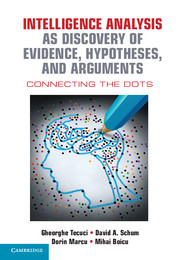Book contents
- Frontmatter
- Contents
- Preface
- Acknowledgments
- About the Authors
- 1 Intelligence Analysis: “Connecting the Dots”
- 2 Marshaling Thoughts and Evidence for Imaginative Analysis
- 3 Disciple-CD: A Cognitive Assistant for Connecting the Dots
- 4 Evidence
- 5 Divide and Conquer: A Necessary Approach to Complex Analysis
- 6 Assessing the Believability of Evidence
- 7 Chains of Custody
- 8 Recurrent Substance-Blind Combinations of Evidence
- 9 Major Sources of Uncertainty in Masses of Evidence
- 10 Assessing and Reporting Uncertainty: Some Alternative Methods
- 11 Analytic Bias
- 12 Learning and Reusing Analytic Expertise: Beyond Disciple-CD
- Glossary of Terms
- References
- Appendixes
- Index
5 - Divide and Conquer: A Necessary Approach to Complex Analysis
Published online by Cambridge University Press: 05 August 2016
- Frontmatter
- Contents
- Preface
- Acknowledgments
- About the Authors
- 1 Intelligence Analysis: “Connecting the Dots”
- 2 Marshaling Thoughts and Evidence for Imaginative Analysis
- 3 Disciple-CD: A Cognitive Assistant for Connecting the Dots
- 4 Evidence
- 5 Divide and Conquer: A Necessary Approach to Complex Analysis
- 6 Assessing the Believability of Evidence
- 7 Chains of Custody
- 8 Recurrent Substance-Blind Combinations of Evidence
- 9 Major Sources of Uncertainty in Masses of Evidence
- 10 Assessing and Reporting Uncertainty: Some Alternative Methods
- 11 Analytic Bias
- 12 Learning and Reusing Analytic Expertise: Beyond Disciple-CD
- Glossary of Terms
- References
- Appendixes
- Index
Summary
HOLISTIC APPROACH TO ANALYSIS
In our work, and in our personal affairs, we can address inference and decision problems at various levels of detail. As an introductory example, we describe a situation in which we do not decompose a problem at all and consider some of the consequences of failure to do any decomposition. Faced with the task of drawing a conclusion about some matter of interest, we may gather some information that seems relevant and believable, think about it for a while, and eventually draw at least a tentative conclusion. We do this all in our own heads without recording any of the stages and details in our analysis. Furthermore, there is usually no orderly structure to our trains of thought in this analysis. This approach has a name: It is called a holistic approach to emphasize the fact that we deal with some problem in its perceived entirety all at once and without any kind of outside assistance or interference. In simple problems involving our own personal affairs, we may do this very frequently. But there are some natural hazards involved in a completely holistic approach to inference and decision problems. The following is a very simple example of what can happen as a result of an entirely holistic approach.
Example 5.1.
Suppose, in discussing with your spouse an upcoming political election, you say that you have reached the conclusion that Person X will be the best candidate. Here are just a few of the questions your spouse might raise while listening to your conclusion:
Your spouse first says, “Tell me what evidence you used to reach the conclusion that X would be the best candidate?” Suppose you say, “Well, I believe I considered evidence A, B, C, and D, that I thought on balance favored X.” Your spouse listens to your account and has further questions.
Your spouse says, “Why did you believe that evidence B was relevant at all? And why did you believe that the source of evidence D deserved to be believed?” You search for answers to these questions and have difficulty deciding what you had previously thought about these matters, if you thought about them at all.
- Type
- Chapter
- Information
- Intelligence Analysis as Discovery of Evidence, Hypotheses, and ArgumentsConnecting the Dots, pp. 82 - 117Publisher: Cambridge University PressPrint publication year: 2016



